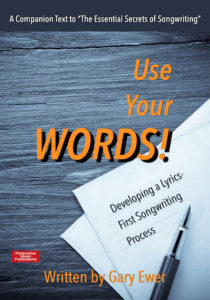When a song melody moves upward, you hear an intensifying of musical energy. That’s because of the nature of the human voice. The higher we sing, the more tension we hear in the voice. You know that when you’re singing at the very top of your range that you hear that bit of strain. In most pop music genres, that strain can be appealing (within reason).
 “Use Your Words! Developing a Lyrics-First Songwriting Process” is free with your purchase of “The Essential Secrets of Songwriting 10-eBook Bundle.”
“Use Your Words! Developing a Lyrics-First Songwriting Process” is free with your purchase of “The Essential Secrets of Songwriting 10-eBook Bundle.”
Where the tension starts to become obvious differs from singer to singer, based on each person’s natural range, called the tessitura.
You can get that same effect in instrumental music as well, because certain instruments also display a kind of tessitura-based tension as they move into the upper register, especially guitar, saxophone and others.
So as song melodies move higher, audiences interpret the increased “noise” in the voice or instrument as an increase of musical momentum. In this context, momentum means that we want to hear how high this is going to go: momentum is an important part of anticipation.
Many songs do this in two or more distinct sections, like Lana Del Rey’s “Blue Jeans“, which dwells mainly in her wonderful low register for a few lines, then jumping upward.
But sometimes the sense of anticipation is even more enhanced when the melody slowly moves upward before eventually moving downward, like these classics:
- Beyond the Sea (Trenet)
- It’s Only Believe (Jack Nance, Conway Twitty)
- Bridge Over Troubled Water (Paul Simon)
- How Deep Is Your Love (Barry, Robin, Maurice Gibb)
- Man In the Mirror (Siedah Garrett, Glen Ballard)
Knowing that you can create musical momentum by doing this can help you in your songwriting process if you follow this kind of plan:
- Start your verse in your lowest range.
- By the midpoint of the verse, start to move higher.
- Start your chorus with notes that are some of the highest ones you’ll use for this song, or…
- Allow the highest notes of the song to happen somewhere around the halfway point of the chorus.
- Finish the chorus with a melodic line that descends.
That’s not the only way to write this kind of rising-melody song of course, but sometimes having a plan like this can help you by creating steps along the way — places where your melody “should” be in order to more carefully structure the momentum. You’ll love the results.
 Written by Gary Ewer. Follow Gary on Twitter
Written by Gary Ewer. Follow Gary on Twitter
 If every music rudiments course has left you bleary-eyed, you need to try “Easy Music Theory by Gary Ewer.” It’s a video-based music theory course that starts at the very beginning (this is a note) and shows you all the rudiments of music in 25 Easy Lessons. It’s time to more fully understand music!
If every music rudiments course has left you bleary-eyed, you need to try “Easy Music Theory by Gary Ewer.” It’s a video-based music theory course that starts at the very beginning (this is a note) and shows you all the rudiments of music in 25 Easy Lessons. It’s time to more fully understand music!










